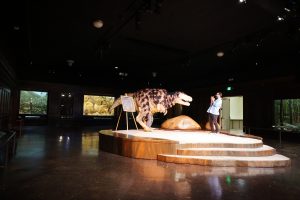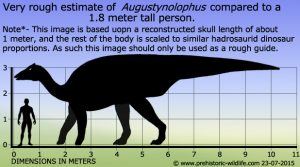Back to Dinosaur Encounters at The Natural History Museum Los Angeles. It was time for Hunter the T-Rex. Kinsey again on spot reserving me a front row seat. Jon plays the Eccentric Paleontologist. Brittany played Jon’s Assistant and Andrew operates Hunter with Lisa & Jaquita behind the scenes handling the tech. Jon does a rough sketch of a T-Rex and provides a T-Rex tooth for show and tell with the excited guests. Hunter arrives and there is a brief bit of terror. A lucky youngster joins Jon for a personal intro to Hunter and some Q & A. It was another great show all the kids from 1 to 92 had a wonderful time.
Next a visit to the Extreme Mammals Exhibit. Waiting to greet you is Indricotherium, the largest land mammal ever discovered. Thirteen feet high at the top of its back. If he raised his head, he surely would lift up the roof! An adult would have weighted over 20 tons, the equivalent of 4 adult African Elephants! You have to see Indricotherium and all the other unusual mammals in person.
Then a return visit to the Butterfly Pavilion. The double entry system and inspection of the guests for hitchhikers on the way out keeps the butterflies in the Pavilion. So many different kinds of butterflies in one place and seeing them up close is a great experience.
A visit to Dinosaur Hall where I took some photos with Magic Memories. The green screen provides a variety of backgrounds for you and your family to choose. Their Team will assist with where to stand in front of the green screen to get the most out of the background you select. I brought a Prehistoric History book to share with the Dinosaurs. The Polar Bears and other Mammals seem interested in Prehistoric History too!
In Dinosaur Hall you can learn all about Augustynolophus morrisi, fondly referred to as Augie. She could be California’s State Dinosaur this summer when the California legislature votes on a measure introduced by Assembly member Richard Bloom of Santa Monica. This duck-billed hadrosaur lived 66 million years ago near now what is now central California. About 30 feet long, these dinosaurs probably browsed the landscape for trees and small plants. Their broad teeth were perfect for grinding chewy leaves. Though Augustynolophus lived on land, some died and were swept out to sea, eventually settling to the bottom of the ocean, which covered much of California those many years ago. The only two know fossil specimens of Augustynolophus in the world reside in the Natural History Museum Los Angeles.
Visit the Museum and learn more. Check out their website for all the museum’s activities www.nhm.org
Wishing you a Week Full of Fun & Discovery!
Paul & Prehistoric Pals
Your feedback is appreciated, Thank you!

















